|
Quantum of Solace (2008) is the twenty-second James Bond film produced by Eon Productions, and is the direct sequel to the 2006 film Casino Royale. Directed by Marc Forster, it features Daniel Craig's second performance as
James Bond. In the film, Bond battles wealthy businessman Dominic Greene (Mathieu Amalric), a member of the Quantum organisation, posing as an environmentalist who intends to stage a coup d'état in Bolivia to seize control of the nation's
water supply. Bond seeks revenge for the death of his lover, Vesper Lynd (Eva Green), and is assisted by Camille Montes (Olga Kurylenko), who is seeking revenge for the murder of her family.
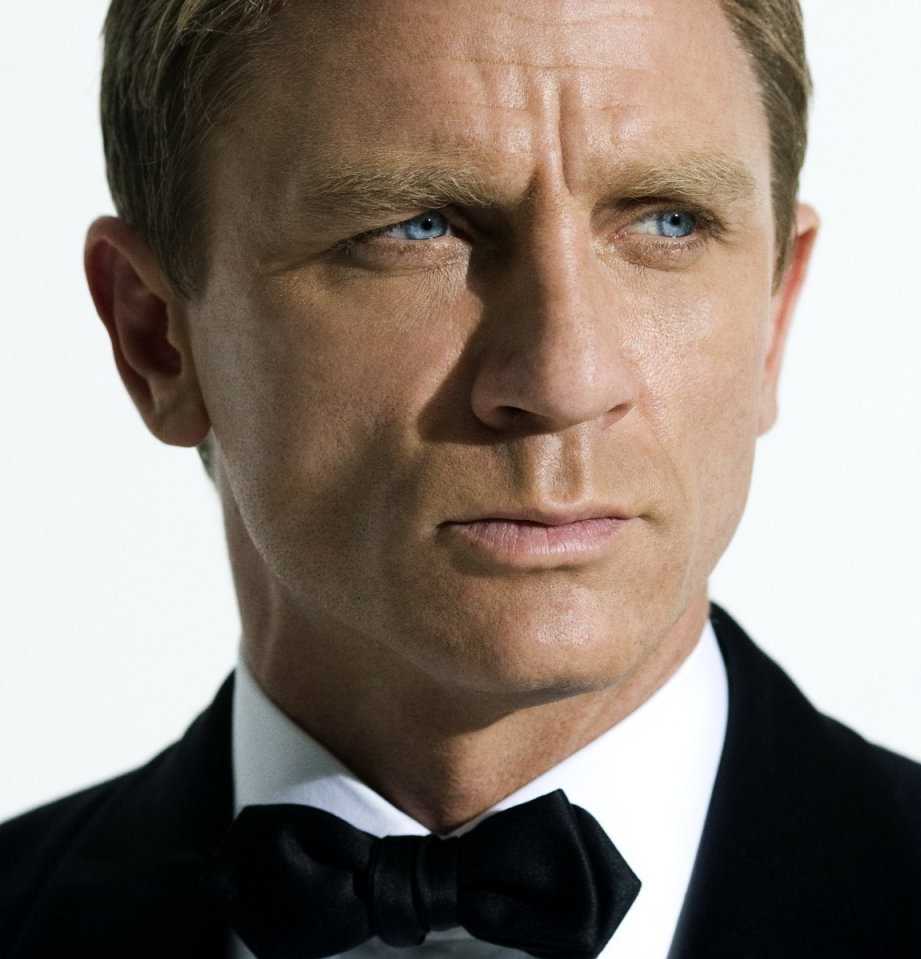
Producer Michael G. Wilson developed the film's plot while Casino Royale was being shot. Neal Purvis, Robert Wade, Paul Haggis, and Joshua Zetumer contributed to the script. The title was chosen from a 1960 short story in Ian Fleming's For Your Eyes Only, though the film does not contain any elements of the original story. Location filming took place in
Mexico, Panama, Chile, Italy,
Austria, and Wales while interior sets were built and filmed at Pinewood Studios. Foster aimed to make a modern film that also featured classic cinema motifs: a vintage Douglas DC-3 was used for a flight sequence, and Dennis Gassner's set designs are reminiscent of Ken Adam's work on several early Bond films. Taking a course away from the usual Bond villains, Forster rejected any grotesque appearance for the character Dominic Greene to emphasise the hidden and secret nature of the film's contemporary villains.
The film premiered at the Odeon Leicester Square on 29 October 2008, gathering mixed reviews which mainly praised Craig's gritty performance and the film's action sequences while feeling that Quantum of Solace was not as impressive as the predecessor Casino Royale. It is also the second-highest-grossing
James Bond film, without adjusting for inflation, earning $586,090,727 worldwide.
James Bond is driving from Lake Como to Siena, Italy, with the captured Mr. White in the boot of his car. After evading pursuers, Bond and M interrogate White regarding his organisation, Quantum. M's bodyguard, Mitchell, a double agent, attacks M, enabling White to escape. Bond chases Mitchell and kills him. Bond and M return to London and search Mitchell's flat, discovering through tagged banknotes that Mitchell had a contact in Haiti. Bond tracks the contact, Edmund Slate, and learns that Slate is a hitman sent to kill Camille Montes at the behest of her lover, environmentalist Dominic Greene. While observing her subsequent meeting with Greene, Bond learns that Greene is helping an exiled
Bolivian General, Medrano—who murdered Camille's family—to overthrow his government in exchange for a seemingly barren piece of desert.
After rescuing Camille from Medrano, Bond follows Greene to a performance of Tosca in Bregenz, Austria. En route, the CIA head of the South American section, Gregg Beam, strikes a non-interference deal with Greene to maintain access to assumed stocks of Bolivian oil. Bond infiltrates Quantum's meeting at the opera, and a gunfight ensues. A Special Branch bodyguard of Quantum member Guy Haines, an advisor to the British Prime Minister, is killed while in combat with Bond, and M—after Bond refuses to obey orders to return home and debrief—has his passports and credit cards revoked.
Bond convinces his old ally René Mathis to accompany him to Bolivia. At the La Paz airport, they are greeted by Strawberry Fields, an MI6 officer, who demands that Bond return to the UK immediately; nonetheless, Bond soon seduces her before they attend a party Greene holds that night. At the party, Bond again rescues Camille from Greene. Leaving, Bond and Camille are pulled over by Bolivian police working for Medrano. They had earlier attacked Mathis and put him in the boot of Bond's car to frame Bond; and, in the ensuing struggle, Mathis is killed. The following day, Bond and Camille survey Quantum's intended land acquisition by air; their plane is shot down after a brief air battle and they skydive out of the burning plane into a sinkhole. In the cave, Bond and Camille discover Quantum are damming Bolivia's supply of fresh water to create a monopoly. Back in La Paz, Bond meets M and learns that Quantum murdered Fields by drowning her in crude oil. M orders Bond arrested for disobeying orders but he escapes. He risks capture by doubling back to tell M that Fields demonstrated bravery in the field, and this is enough to convince M that Bond can be trusted.
Bond meets with CIA agent Felix Leiter, who discloses Greene and Medrano will meet in the Atacama Desert to finalise the coup. Warned by Leiter, he evades the CIA's Special Activities Division when they attempt to kill him. At the hotel, Greene and Medrano negotiate their terms. Greene then finally reveals his true plans: now that he controls the majority of Bolivia's water supply, Greene forces Medrano to accept a new contract that makes Greene Planet Bolivia's sole water utility company at significantly higher rates. Bond infiltrates the hotel, kills the Chief of Police for betraying Mathis, and confronts Greene. The hotel is destroyed during the ensuing struggle; Camille kills Medrano, avenging the murders of her parents and sister, and Bond captures Greene. After interrogating him about Quantum, Bond leaves Greene stranded in the middle of the desert with only a can of engine oil. Bond and Camille kiss before they part.
Bond travels to Kazan, Russia, where he finds Vesper Lynd's former lover, Yusef Kabira, with a new target, a Canadian agent. Yusef is a member of Quantum who seduces women with valuable connections. Bond decides not to kill Yusef and allows
MI6 to arrest him. Outside, M tells Bond that Greene was found in the middle of the desert dead, shot twice and with engine oil in his stomach; Bond denies knowing anything. M also reveals that Leiter has been promoted and has taken Beam's place. She reinstates Bond as an agent; he tells M that he never left. As he leaves, he drops Vesper's necklace in the
snow.
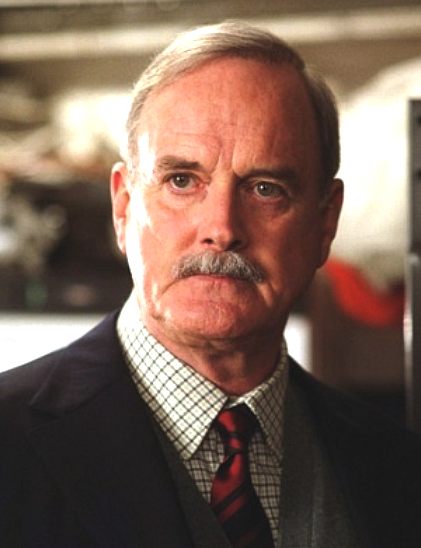
John
Cleese as Q
CAST
Daniel Craig as James Bond.
Craig's physical training for his reprise of the role placed extra effort into running and
boxing, to spare him the injuries he sustained on his stunts in the first film. Craig felt he was fitter, being less bulky than in the first
film. He also practiced speedboating and stunt driving. Craig felt Casino Royale was [physically] "a walk in the park" compared to Quantum of
Solace, and required a different performance from him because Quantum of Solace is a revenge film, not a love story like Casino
Royale. While filming in Pinewood, he suffered a gash when kicked in his
face, which required eight stitches, and a fingertip was sliced off. He laughed these off, noting they did not delay filming, and joked his finger wound would enable him to have a criminal career (though it had grown back when he made this
comment). He also had minor plastic surgery on his face. The actor advised Paul Haggis on the script and helped choose Marc Forster as the
director.
Olga Kurylenko as Camille Montes
A
Bolivian agent with her own vendetta regarding Greene and Medrano. Forster chose her because out of the 400 women who auditioned, she seemed the least nervous. When she read the script, she was glad she had no love scene with Craig; she felt it would have distracted viewers from her
performance. Kurylenko spent three weeks training to fight with weapons, and she learned a form of indoor skydiving known as body
flying. Kurylenko said she had to do "training non-stop from the morning to the evening" for the action scenes, overcoming her fears with the help of Craig and the stunt
team. She was given a DVD box set of Bond films, since the franchise was not easily available to watch in her native
Ukraine. Kurylenko found Michelle Yeoh in Tomorrow Never Dies inspiring "because she did the fight scenes by
herself." The producers had intended to cast a South American actress in the
role. Kurylenko trained with a dialect coach to perform with a Spanish
accent. She said that the accent was easy for her because she has "a lot of hispanic friends, from Latin America and Spain, and it’s an accent I’ve always
heard". When reflecting on her experience as a Bond girl, she stated she was most proud of overcoming her fears in performing
stunts.
Mathieu Amalric as Dominic Greene
The main villain. He is a leading member of Quantum posing as a businessman working in reforestation and charity funding for environmental science. Amalric acknowledged taking the role was an easy decision because, "It's impossible to say to your kids that 'I could have been in a Bond film but I
refused.'" Amalric wanted to wear make-up for the role, but Forster explained that he wanted Greene not to look grotesque, but to symbolise the hidden evils in
society. Amalric modelled his performance on "the smile of Tony Blair [and] the craziness of Sarkozy," the latter of whom he called "the worst villain we [the
French] have ever had ... he walks around thinking he's in a Bond
film." He later claimed this was not criticism of either politician, but rather an example of how a politician relies on performance instead of a genuine policy to win power. "Sarkozy, is just a better actor than [his presidential opponent] Ségolène Royal—that's all," he
explained. Amalric and Forster reconceived the character, who was supposed to have a "special skill" in the script, to someone who uses pure animal instinct when fighting Bond in the
climax. Bruno Ganz was also considered for the part, but Forster decided Amalric gave the character a "pitiful"
quality.
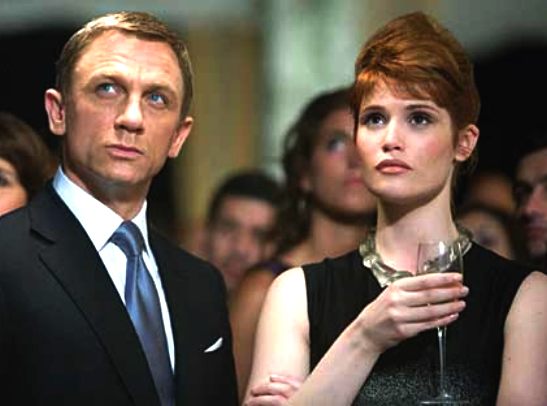
Gemma Arterton as MI6 Agent Strawberry Fields
Who works at the
British consulate in Bolivia. Fields, who is merely an office worker as described by M, takes herself seriously and tries to over-power Bond when the pair meet. She is later seduced by Bond, infiltrates Greene's fund raiser party with him and ends up paying the ultimate price. Forster found Arterton a witty actress and selected her from a reported 1,500 candidates. One of the casting directors asked her to audition for the role, having seen her portray Rosaline in Love's Labour's Lost at the Globe
Theatre. Arterton said Fields was "not so frolicsome" as other Bond girls, but is instead "fresh and young, not ... a femme
fatale." Arterton described Fields as a homage to the 1960s Bond girls, comparing her red wig to that of Diana Rigg, who played Tracy Bond in On Her Majesty's Secret Service. Rigg, alongside Honor Blackman, is one of her favourite Bond
girls. Arterton had to film her character's death scene first day on the set, where she was completely covered head to toe in non-toxic black paint. Although she found the experience unpleasant, she believes the scene will be an iconic part of the
film. The character's first name, which is a reference to the Beatles song "Strawberry Fields Forever", is never actually uttered on screen; when Bond asks her for her name, she replies, "Just Fields." Robert A. Caplen suggests that this is a conscious effort to portray a woman "whose character attributes are neither undermined nor compromised" by her name, even though her name may have sexual overtones reminiscent of earlier Bond
girls.
Giancarlo Giannini as René Mathis
Bond's ally who was mistakenly believed to be a traitor in Casino Royale. Having been acquitted, he chooses to aid Bond again in his quest to find out who betrayed him.
Jeffrey Wright as Felix Leiter
Bond's ally at the CIA. This marked the first time the same actor played Leiter twice in a row. Only David Hedison had previously played the character twice, in Live and Let Die (1973) and Licence to Kill (1989), but these performances were not
consecutive. Early script drafts gave Leiter a larger role, but his screentime was restricted by on-set
rewrites.
Judi Dench as M
Forster felt Dench was underused in the previous films and wanted to make her part bigger, having her interact with Bond more because she is "the only woman Bond doesn’t see in a sexual context," which Forster finds
interesting.
Anatole Taubman as Elvis
Greene's second-in-command. Taubman wanted to make Elvis "as colorful, as edgy and as interesting as possible", with one of his suggestions being the bowl cut. Amalric and Taubman improvised a backstory for Elvis: he is Dominic's cousin and once lived on the streets before being inducted into Quantum. He called Elvis "a bit of a goofball. He thinks he's all that but he's not really. ... He's not a comic guy. He definitely takes himself very serious, but maybe by his taking himself too serious he may become
friendly."
David Harbour as Gregg Beam
The CIA Section Chief for South America and a contact of Felix Leiter.
Joaquín Cosío as General Medrano
The exiled general whom Greene is helping to get back into power, in return for support of his organisation. He murdered Camille's entire family when she was a young girl.
Fernando Guillen Cuervo as Carlos
The Colonel of Bolivian Police, the chief of all police forces, and the contact of René Mathis in Bolivia.
Jesper Christensen as Mr. White
Whom Bond captured after he stole the money won at Casino Royale in Montenegro.
Rory Kinnear as Bill Tanner - M's aide.
Tim Pigott-Smith - as the British Secretary of State for Foreign and Commonwealth
Affairs
Neil Jackson
- as Edmund Slate, a henchman who fights Bond in Haiti.
Simon Kassianides
- as Yusef, a member of Quantum who seduces female agents and manipulates them into giving away classified information. He is indirectly responsible for Vesper Lynd's death.
Stana Katic
- as Corrine Veneau, a Canadian agent and Yusef's latest target.
Glenn Foster
- as Craig Mitchell, M's bodyguard and a double agent.
Oona Castilla Chaplin
- as "damsel in distress"—girl saved by Camille Montes in one of last sequences.
Lucrezia Lante Della Rovere as Gemma, Mathis' girlfriend.
Elizabeth Arciniega
- as Mr. White's girlfriend.
Marc Forster asked his friends and fellow directors Guillermo del Toro and Alfonso Cuarón to appear in cameos. Cuarón appears as a Bolivian helicopter pilot, while del Toro provides several other voices
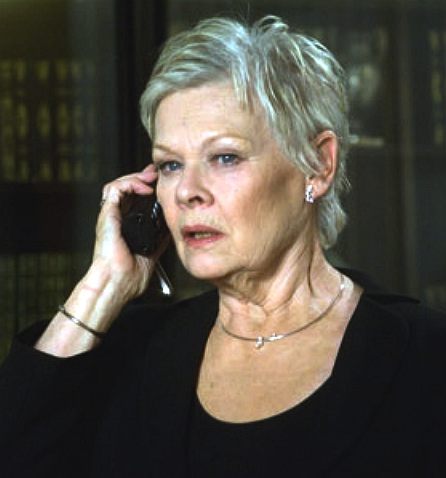
Judi
Dench as M
PRODUCTION & DEVELOPMENT
"If you remember in Chinatown, if you control the water you control the whole development of the country. I think it's true. Right now it appears to be oil, but there's a lot of other resources that we don't think about too much but are all essential, and they're very limited and every country needs it. Because every country knows that raising the standard of living (and populations are getting bigger) is the way we're all going."
—Michael G. Wilson on the plot.
In July 2006, as Casino Royale entered post-production, Eon Productions announced that the next film would be based on an original idea by producer Michael G.
Wilson. It was decided beforehand the film would be a direct sequel, to exploit Bond's emotions following Vesper's death in the previous
film. Just as Casino Royale's theme was terrorism, the sequel focuses on
environmentalism. The film was confirmed for a 2 May 2008 release date, with Craig reprising the lead
role. Roger Michell, who directed Craig in Enduring Love and The Mother, was in negotiations to direct, but opted out because there was no
script. Sony Entertainment vice-chairman Jeff Blake admitted a production schedule of 18 months was a very short window, and the release date was pushed back to late
2008. Neal Purvis and Robert Wade completed their draft of the script by April
2007, and Paul Haggis, who polished the Casino Royale script, began his rewrite the next
month.
In June 2007, Marc Forster was confirmed as director. He was surprised that he was approached for the job, stating he was not a big Bond film fan through the years, and that he would not have accepted the project had he not seen Casino Royale prior to making his decision: he felt Bond had been humanised in that film, arguing since travelling the world had become less exotic since the series' advent, it made sense to focus more on Bond as a character. Born in Germany and raised in Switzerland, Forster was the first Bond director not to come from the British Commonwealth of Nations, although he noted Bond's mother is Swiss, making him somewhat appropriate to handle the British
icon. The director collaborated strongly with Barbara Broccoli and Michael G. Wilson, noting they only blocked two very expensive ideas he
had. The director found Casino Royale's 144-minute running time too long, and wanted his follow-up to be "tight and fast ... like a
bullet."
Marc Forster on the political landscape of the
film:
"Because Bond plays it real, I thought the political circumstances should be real too, even though Bond shouldn't be a political film. I thought the more political I make it, the more real it feels, not just with Bolivia and what's happening in Haiti, but with all these corporations like Shell and Chevron saying they're green because it's so fashionable to be green. During the Cold War, everything was very clear, the good guys and the bad guys. Today there's much overlapping of good and bad. It isn't as morally distinct, because we all have both elements in us."
Haggis, Forster and Wilson rewrote the story from scratch. Haggis said he completed his script two hours before the 2007–2008 Writers Guild of America strike officially
began. Forster noted a running theme in his films were emotionally repressed protagonists, and the theme of the picture would be Bond learning to trust after feeling betrayed by Vesper. Forster said he created the Camille character as a strong female counterpart to Bond rather than a casual love interest: she openly shows emotions similar to those which Bond experiences but is unable to
express. Haggis located his draft's climax in the Swiss Alps, but Forster wanted the action sequences to be based around the four classical elements of earth, water, air and
fire. The decision to homage Goldfinger in Fields's death came about as Forster wanted to show oil had replaced gold as the most precious
material. The producers rejected Haggis's idea that Vesper Lynd had a child, because "Bond was an orphan ... Once he finds the kid, Bond can't just leave the
kid." The water supply issue in Bolivia was the main theme of the film, with a story based on the Cochabamba Water
Revolt.
Michael G. Wilson decided on the film's title Quantum of Solace only "a few days" before its announcement on 24 January
2008. It was the name of a short story in Ian Fleming's anthology For Your Eyes Only
(1960). The film is related to the title in one of its thematic elements: "when the 'Quantum of Solace' drops to zero, humanity and consideration of one human for another is
gone." Daniel Craig admitted, "I was unsure at first. Bond is looking for his quantum of solace and that's what he wants, he wants his closure. Ian Fleming says that if you don't have a quantum of solace in your relationship then the relationship is over. It's that spark of niceness in a relationship that if you don't have you might as well give
up." He said that "Bond doesn't have that because his girlfriend [Vesper Lynd] has been
killed," and therefore, "[Bond is] looking for revenge ... to make himself happy with the world
again." Afterwards, Quantum was made the name of the organisation introduced in Casino
Royale. Craig noted the letter Q itself looks rather odd. Near the end of the film, the Camille Montes character and Bond have a discussion about their individual quests to avenge the deaths of their loved ones. Montes asks Bond to "let me know what it feels like" when he succeeds, the implication of the title being that it will be a small amount of solace compared to his despair. Bond's lack of emotion when he does exact revenge shows this to be the case.
According to a December 2011 interview with Craig, "We had the bare bones of a script and then there was a writers' strike and there was nothing we could do. We couldn't employ a writer to finish it. I say to myself, 'Never again', but who knows? There was me trying to rewrite scenes—and a writer I am
not." He said that he and Forster "were the ones allowed to do it. The rules were that you couldn't employ anyone as a writer, but the actor and director could work on scenes together. We were stuffed. We got away with it, but only just. It was never meant to be as much of a sequel as it was, but it ended up being a sequel, starting where the last one
finished."
During filming, after the strike ended, Forster read a spec script by Joshua Zetumer, which he liked, and hired him to reshape scenes for the later parts of the shoot, which the director was still unsatisfied
with. Forster had the actors rehearse their scenes, as he liked to film scenes
continually. Zetumer rewrote dialogue depending on the actors' ideas each day
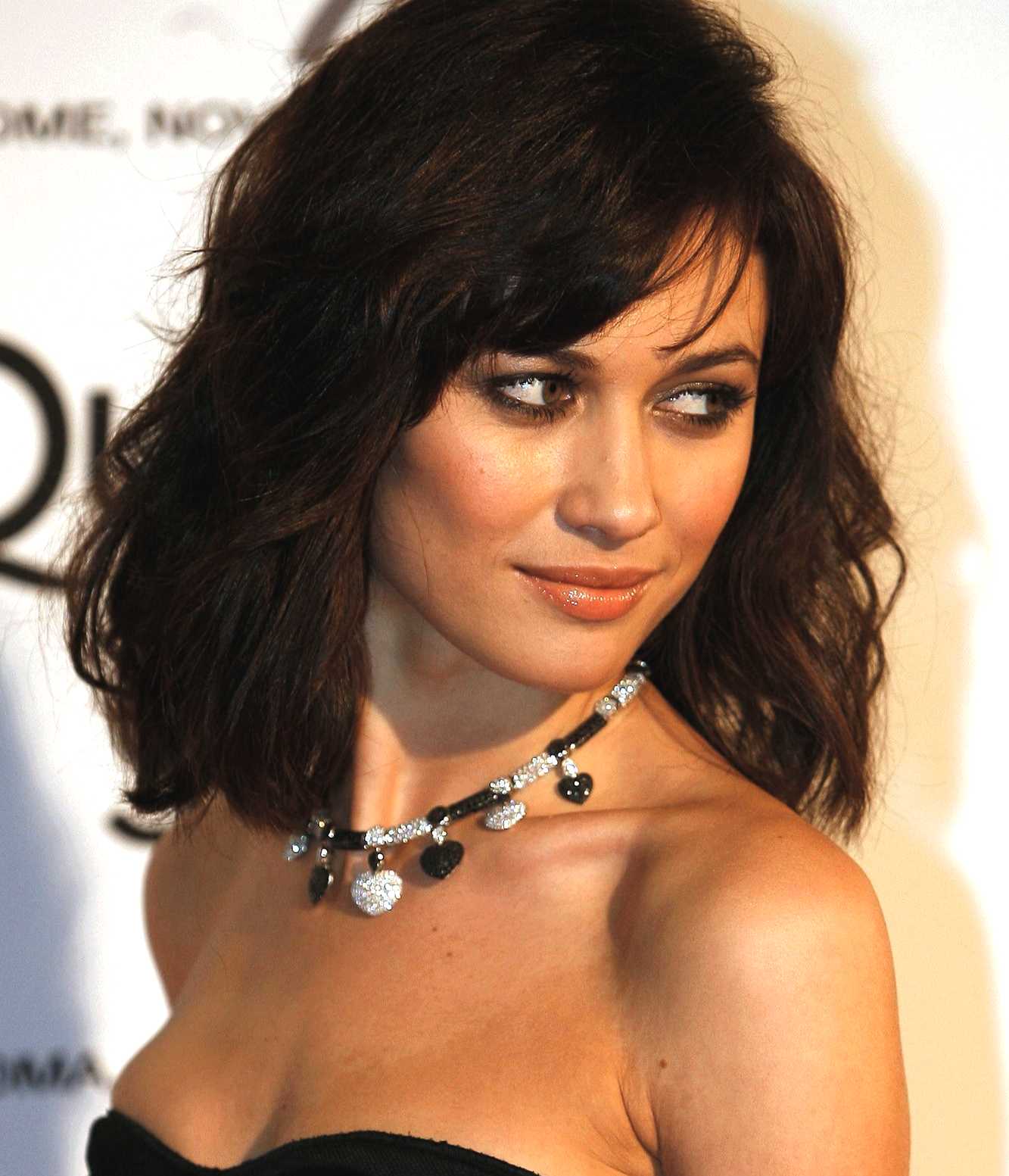
Olga
Kurylenko
Filming
Quantum of Solace was shot in six
countries, Second unit filming began in Italy at the Palio di Siena horse race on 16 August
2007: though at this point Forster was unsure how it would fit into the
film. Some scenes were filmed also in Maratea and Craco, two small distinctive towns in Basilicata in southern
Italy. Other places used for location shooting were Madrid in August
2007; Baja California,
Mexico in early 2008, for shots of the aerial
battle; Malcesine, Limone sul Garda and Tremosine in Italy during
March, and at Talamone during the end of April. The main unit began on 3 January
2008, at Pinewood Studios. The 007 Stage was used for the fight in the art
gallery, and an MI6 safehouse hidden within the city's cisterns, while other stages housed Bond's Bolivian hotel
suite, and the MI6 headquarters. Interior and exterior airport scenes were filmed at Farnborough Airfield and the snowy closing scenes were filmed at the Bruneval Barracks in
Aldershot.
Shooting in Panama City began on 7 February 2008 at Howard Air Force Base. The country doubled for Haiti and Bolivia, with the National Institute of Culture of Panama standing in for a hotel in the latter country. A sequence requiring several hundred extras was also shot at nearby Colón. Shooting in
Panama was also carried out at Fort Sherman, a former US military base on the Colón coast. Forster was disappointed he could only shoot the boat chase in that harbour, as he had a more spectacular vision for the
scene. Officials in the country worked with the locals to "minimise inconvenience" for the cast and crew, and in return hoped the city's exposure in the film would increase
tourism. The crew was going to move to Cusco, Peru for ten days of filming on 2
March, but the location was cancelled for budget reasons. Twelve days of filming in Chile began on 24 March at Antofagasta. There was shooting in Cobija, the Paranal Observatory, and other locations in the Atacama
Desert. Forster chose the desert and the observatory's ESO Hotel to represent Bond's rigid emotions, and being on the verge of committing a vengeful act as he confronts Greene in the film's
climax.
While filming in Sierra Gorda, Chile, the local mayor, Carlos Lopez, staged a protest because he was angry at the filmmakers' portrayal of the Antofagasta region as part of Bolivia. He was arrested, detained briefly, and put on trial two days later. Eon dismissed his claim that they needed his permission to film in the
area. Michael G. Wilson also explained Bolivia was appropriate to the plot, because of the country's history of water problems,[65] and was surprised the two countries disliked each other a century after the War of the Pacific.[68] In a poll by Chilean daily newspaper La Segunda, 75% of its readers disagreed with Lopez's actions, due to the negative image they felt it presented of Chile, and the controversy's potential to put off productions looking to film in the country in the
future.
From 4–12 April, the main unit shot on Sienese rooftops. Shooting on the real rooftops turned out to be less expensive than building them at
Pinewood. The next four weeks were scheduled for filming the car chase at Lake Garda and
Carrara. On 19 April, an Aston Martin employee driving a DBS to the set crashed into the lake. He survived, and was fined £400 for reckless
driving. Another accident occurred on 21 April, and two days later, two stuntmen were seriously injured, with one, Greek stuntman Aris Comninos, having to be put in intensive care. Filming of the scenes was temporarily halted so that Italian police could investigate the causes of the
accidents. Stunt co-ordinator Gary Powell said the accidents were a testament to the realism of the
action. Rumours of a "curse" spread among tabloid media, something which deeply offended Craig, who disliked that they compared Comninos' accident to something like his minor finger injury later on the shoot (also part of the "curse"). Comninos recovered safely from his
injury.
Filming took place at the floating opera stage at Bregenz, Austria, from 28 April – 9 May 2008. The sequence, where Bond stalks the villains during a performance of Tosca, required 1500
extras. The production used a large model of an eye, which Forster felt fitted in the Bond style, and the opera itself has parallels to the
film. A short driving sequence was filmed at the nearby Feldkirch,
Vorarlberg. The crew returned to Italy from 13–17 May to shoot a (planned) car crash at the marble quarry in
Carrara, and a recreation of the Palio di Siena at the Piazza del Campo in Siena. 1000 extras were hired for a scene where Bond emerges from the Fonte Gaia. Originally, he would have emerged from the city's cisterns at Siena Cathedral, but this was thought
disrespectful. By June, the crew returned to Pinewood for four
weeks, where new sets (including the interior of the hotel in the climax) were
built. The wrap party was held on 21 June.
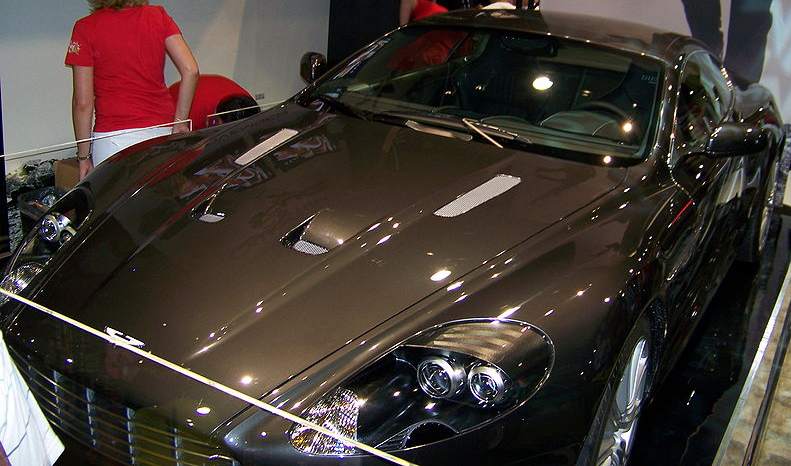
SPECIAL
EFFECTS
Quantum of Solace was the last in Ford Motor's three-film deal that began with 2002's Die Another Day. Although Ford sold over 90% of the Aston Martin company in 2007, the Aston Martin DBS V12 returned for the film's car chase around Lake
Garda; Dan Bradley was hired as second unit director because of his work on the second and third Bourne films, so the film would continue the gritty action style begun in Casino
Royale. He had intended to use Ford GTs for the opening chase, but it was replaced by the Alfa Romeo
159. After location filming in Italy, further close-ups of Craig, the cars and the truck were shot at Pinewood against a
bluescreen. Originally three Alfa Romeos were in the sequence: but Forster felt the scene was running too long and re-edited the scene so it only looked like two Romeos were chasing
Bond. Six Aston Martins were destroyed during filming, and one of them was purchased by a
fan.
Fourteen cameras were used to film the Palio di Siena, footage which was later edited into the main sequence. Aerial shots using helicopters were banned, and the crew were also forbidden from showing any violence "involving either people or
animals." To shoot the foot chase in Siena in April 2008 four camera cranes were built in the town, and a cable camera was also
used. Framestore worked on the Siena chase, duplicating the 1000 extras during principal photography to match shots of the 40,000 strong audience at the real Palio, removing wires that held Craig and the stuntmen in the rooftop segment of the chase, and digital expansion of the floor and skylight in the art gallery Bond and Mitchell fall
into. The art gallery fight was intended to be simple, but during filming Craig's stunt double accidentally fell from the construction scaffolding. Forster preferred the idea of Bond hanging from ropes reaching for his gun to kill Mitchell, rather than having both men run out of the building to continue their chase as specified in the script, and the number of effects shots
increased.
To film the aerial dogfight, a "Snakehead" camera was built and placed on the nose and tail of a Piper Aerostar 700. SolidWorks, who provided the
software used to design the
camera, stated "pilots for the first time can fly as aggressively as they dare without sacrificing the drama of the shot." The camera could turn 360 degrees and was shaped like a
periscope. The crew also mounted SpaceCams on helicopters, and placed cameras with 1600 mm lenses underground, to cover the
action. Forster wanted to film the plane fight as a homage to Alfred Hitchcock's North by Northwest, and chose planes like the Douglas DC-3 to suit
that.
The free-fall scene involved its own set of challenges, Craig disliked the idea of "being hung by wires and blown by a large fan in front of a green screen" but actual sky diving coverage has serious drawbacks. It’s not only difficult, dangerous and time-consuming, but nearly always results in problematic head-replacements for close-ups. Stunt co-ordinator Gary Powell and VFX Designer Kevin Tod Haug, presented the idea of filming the scene in a large vertical wind tunnel in Bedford in order to do this sequence as practically as possible. While a great solution for the actors’ performances the technique presented enormous VFX challenges: relighting shots captured in a tall white tube to match the sky over the Bolivian desert, and the impossibility of filming medium to wide shots of the actors. An array of eight Dalsa Origin
cameras (supported by 7 HD cameras and a 35mm hand-held
camera, all running in sync) was used to create a virtual camera with which to shoot the actors floating in the simulator. Ged Wright and his team at Double
Negative developed a method to use the data from these cameras that allowed these real performances to be placed in a synthetic environment as seen by a synthetic camera. During the shooting in the wind tunnel Craig and Kurylenko wore wind-resistant contact lenses that enabled them to open their eyes as they fell. For safety and comfort, they only shot for thirty seconds at a
time. Forster wished he had more time to work on the free-fall
scene.
The Moving Picture Company created the climactic hotel sequence. The fire effects were supervised by Chris Corbould, and post-production MPC had to enhance the sequence by making the smoke look closer to the actors, so it would look more
dangerous. A full-scale replica of the building's exterior was used for the exploding part Bond and Camille escape from. The boat chase was another scene that required very little CGI. Machine FX worked on replacing a few shots of visible stuntmen with a digital version of Craig's
head, and recreated the boats Bond jumps over on his motorcycle to make it look more
dangerous. Crowd creation was done for the Tosca scene by Machine FX, to make the performance look like it had sold
out. Forster edited the opera scene to resemble The Man Who Knew Too
Much. In total, there are 900+ visual effects shots in Quantum of Solace
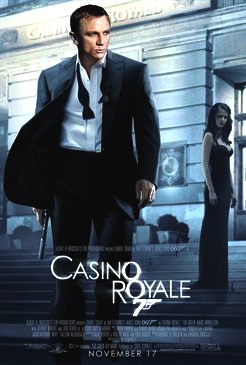
Quantum
of Solace film poster
LINKS
|
Quantum
car chase - Youtube
|
Theme
song - Youtube
|
|
Casino
walk by - Youtube
|
Poison
hand - Youtube
|
LINKS:

A
taste for adventure
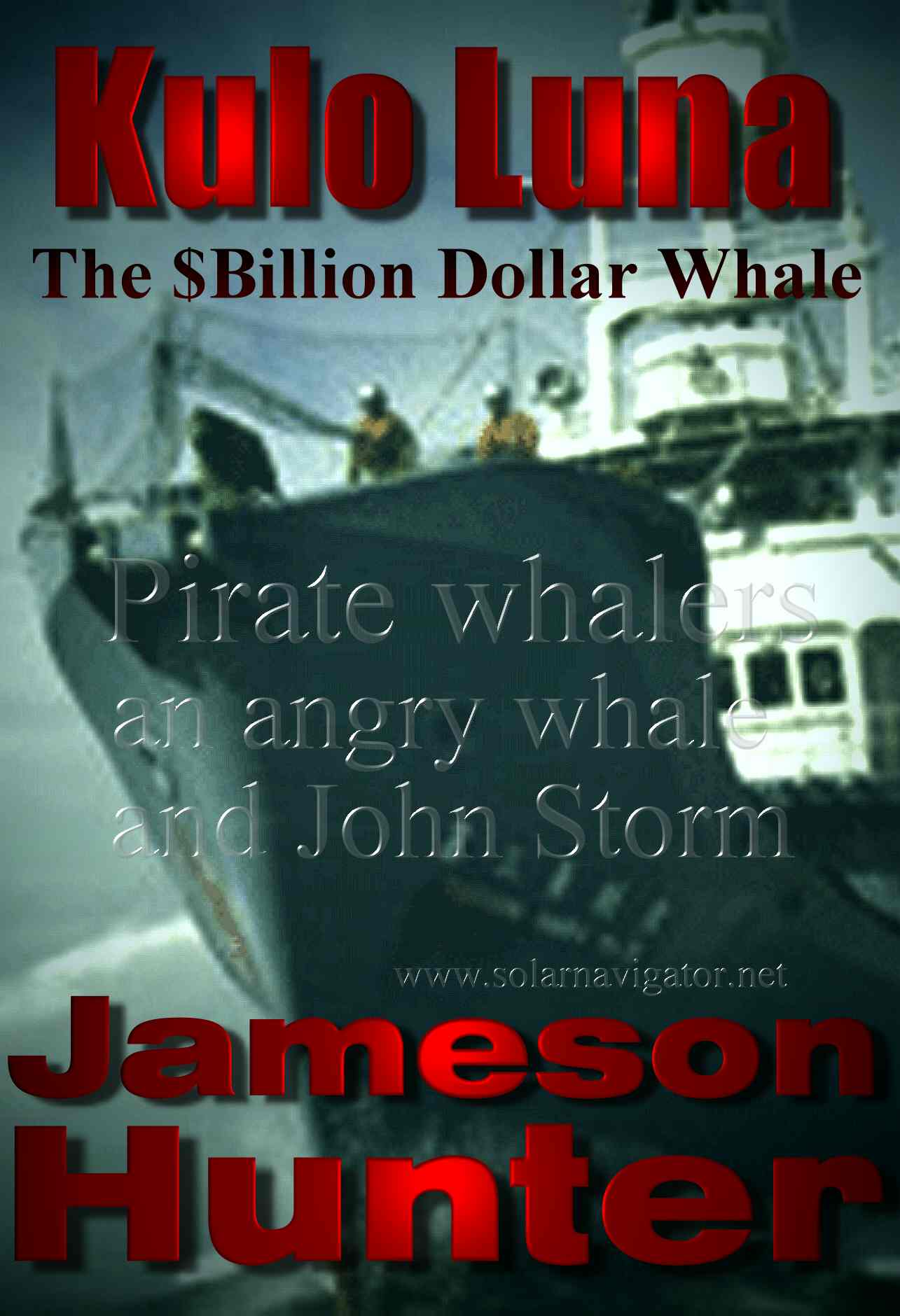
A
heartwarming adventure: pirate
whalers V conservationists
with
a boat that James Bond would die for
|






